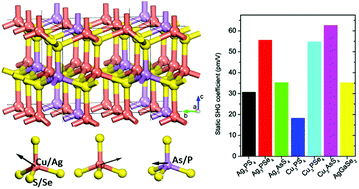Screening novel candidates for mid-IR nonlinear optical materials from I3–V–VI4 compounds†
Abstract
Although numerous superior nonlinear optical (NLO) crystals for the UV-vis to the near-infrared (IR) region have been established, the development of an efficient NLO material capable of broadband second harmonic generation (SHG) in the mid-IR region is still a big challenge. In this work, we performed hybrid functional calculations to accurately assess the mid-IR NLO capabilities of a group of I3–V–VI4 compounds (with I = Ag or Cu, V = P or As, and VI = S or Se). The linear and nonlinear optical properties of these crystals were predicted and analyzed. This group of compounds display moderate optical anisotropy of refraction (0.1 > Δn > 0.03) to fulfill the phase-matching conditions. In particular, the static SHG coefficients of Cu3AsS4, Ag3PSe4 and Cu3PSe4 are predicted to be about twice that of the benchmark AgGaSe2. A detailed analysis of their precise electronic structures and local dipole moments suggests that it is the coupling of the large dipole moment vector of the constituent asymmetry [I–VI4] tetrahedron and the strong covalent character between V and VI ions that contributes to the large SHG response. These candidates would promote the development of the mid-IR NLO functional materials.



 Please wait while we load your content...
Please wait while we load your content...